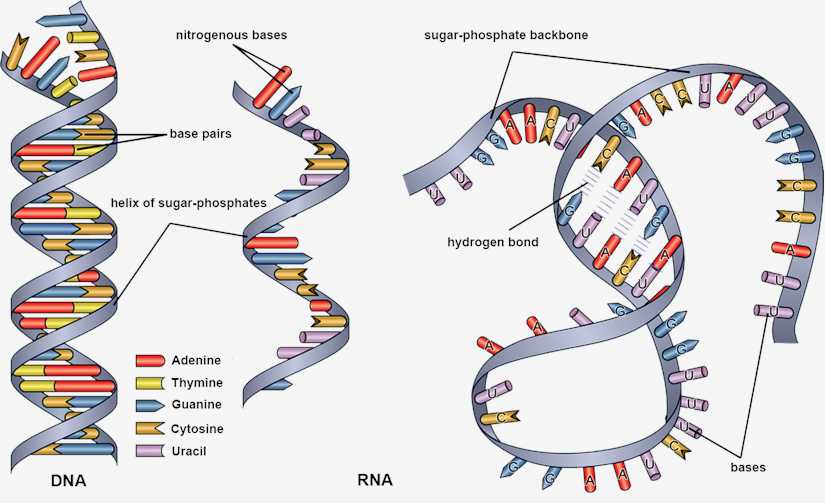Nucleic Acid Structure
The genetic information of the cells is stored in nucleic acids, usually deoxyribonucleic acid (abbreviated as DNA). The information stored in the sequence is transformed into a functional protein molecule through the translation process, and the ribonucleic acid (abbreviated as RNA) molecule is used as a messenger to transmit information between the DNA and the translation machine. RNA molecules can also store information, such as in some viruses, in addition, RNA plays an important role in other processes. The core metabolic processes associated with nucleic acids are replication, transcription, and regulation, all of which rely on the recognition of nucleic acid sequences by proteins. Therefore, it is very important to understand the structural information of DNA and RNA to gain insight into the biological problems associated with the interaction of nucleic acids and proteins.
 Figure 1. Diagram of DNA and RNA.
Figure 1. Diagram of DNA and RNA.
The Building Blocks of Nucleic Acid: Nucleotide
Both DNA and RNA are called nucleic acids. They are given this name because they consist of building blocks called nucleotides. The nucleotide has a ribose or 2'-deoxyribose as the backbone, a phosphate group is attached to the 5'-hydroxyl group of the pentose, and a base is bonded to a 1'-carbon atom. In a nucleic acid polymer, the phosphate group of one nucleotide is linked to the 3'-hydroxyl group on the pentose of the next nucleotide, therefore, the nucleic acid molecule has a 5' end and a 3' end.
- Sugars
Ribose is present in the RNA, while 2'-deoxyribose is present in the DNA. The carbon atoms of the pentose are numbered in the order of 1'-5'. The only difference between ribose and 2'-deoxyribose is that only the 2'- hydroxyl group does not appear in the latter. The 2'-hydroxyl group may contribute to the catalytic properties of the RNA molecules.
- Bases
There are two main types of purines in nucleic acids, namely adenine (A) and guanine (G), but many isomers exist. DNA has two types of pyrimidines, cytosine (C) and thymine (T). In RNA, thymine is usually replaced by a very similar base, uracil (U), which lacks a methyl group compared to the former. Mammalian DNA has been found to contain a methylated base, 5-methylcytosine (m5C). In addition, bacterial DNA contains two additional methylated bases, N6-methyladenine (m6A) and N4-methylcytosine (m4C).
- Phosphates
The phosphate group is made up of central phosphorus surrounded by four oxygens. The Phosphorus combines with three oxygens via three single bonds and binds to the fourth via a double bond. Because of the nature of the chemical bonds, there is a negative charge on each oxygen that has only one bond coming off of it. This negative charge accounts for the total negative charge on the phosphate backbone of the nucleic acid molecule.
| Comparison | Deoxyribonucleic Acid (DNA) | Ribonucleic Acid (RNA) |
| Nucleotide |
|
|
| Structure | The most DNA molecule consists of two strands arranged in a double helix. | RNA has only one strand, which is shorter than the DNA strand. RNA can form secondary structure motifs such as double helix, hairpin loop, and internal loop, and can also form three-dimensional structures. |
| Function | DNA replicates and stores genetic information. It is a blueprint for all genetic information in the organism. | RNA converts the genetic information contained in the DNA into a format for constructing the protein and then transfers it to the ribosome protein factory. |
| Location | DNA is present in the nucleus, and a small amount of DNA is also found in mitochondria and chloroplasts. | RNA is formed in the nucleolus and then moves to specific regions of the cytoplasm according to the type of RNA formed. |
| Reactivity | Because of its deoxyribose, which contains one less oxygen-containing hydroxyl group, DNA is a more stable molecule than RNA and can be utilized to protect genetic information. | RNA is more reactive than DNA and unstable under alkaline conditions. The larger helical groove of RNA means that it is more susceptible to attack by enzymes. |
Table 1. The comparison of DNA and RNA.
Creative Biostructure is specialized in the field of structural biology, and we provide contract services for the structural analysis of DNA and RNA samples.